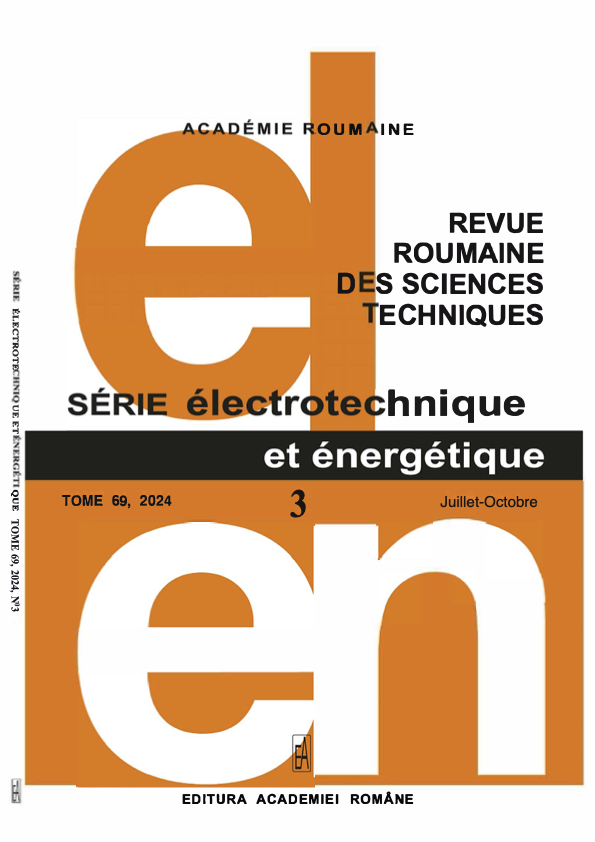CONTRÔLEUR DE PLATEFORME PARALLÈLE BASÉ SUR UN ALGORITHME DE DIFFÉRENCE ADAPTATIVE – PARTIE 2
DOI :
https://doi.org/10.59277/RRST-EE.2024.69.3.14Mots-clés :
Contrôle de l'espace de travail, Contrôleur prédictif de modèle (MPC), Algorithme de différence adaptatif, Contrôle de plate-forme parallèleRésumé
Il existe deux approches principales du contrôle de mouvement sur les plates-formes parallèles : le contrôle de l'espace commun et le contrôle de l'espace de travail. Le contrôle spatial conjoint est une stratégie en boucle semi-fermée facile à mettre en œuvre, mais son effet de contrôle pourrait être meilleur. Le contrôle de l'espace de travail consiste à obtenir la position en temps réel de la plate-forme parallèle via la solution avancée et à fermer la boucle de vitesse et de position de la plate-forme parallèle dans l'espace de travail. Cet article utilise un contrôleur prédictif de modèle (MPC) pour contrôler la plate-forme parallèle avec le contrôle de l'espace de travail comme objectif de recherche. La fonction de perte est construite sur la base de l'idée d'optimisation de l'intelligence en essaim et l'algorithme de différence adaptative est utilisé pour optimiser les paramètres de MPC. Cette partie utilise MATLAB pour réaliser des expériences de simulation afin de compléter l'algorithme de planification de trajectoire de vitesse en forme de S. De plus, l'effet de contrôle du MPC et du contrôleur PI à boucle de position dans un environnement de perturbation robuste est comparé. Les expériences montrent que MPC présente les avantages d'une faible consommation d'énergie et d'une grande précision de contrôle.
Références
(1) J. Ma, H. Li, Research on rosenbrock function optimization problem based on improved differential evolution algorithm. Journal of Computer and Communications 7, 107-120 (2019).
(2) A. Omeradzic, H.-G. Beyer, in Parallel Problem Solving from Nature–PPSN XVII: 17th International Conference, PPSN 2022, Dortmund, Germany, September 10–14, 2022, Proceedings, Part II. pp. 499-511, (Springer, 2022).
(3) M. Pant, H. Zaheer, L. Garcia-Hernandez, A. Abraham, Differential Evolution: A review of more than two decades of research. Engineering Applications of Artificial Intelligence 90, 103479 (2020).
(4) T-C Chiang, C-N Chen and Y-C Lin, Parameter control mechanisms in differential evolution: A tutorial review and taxonomy, in 2013 IEEE Symposium on Differential Evolution (SDE), 2013, IEEE, pp. 1-8.
(5) B Zhang, X Sun, S Liu, X Deng, Tracking control of multiple unmanned aerial vehicles incorporating disturbance observer and model predictive approach, Transactions of the Institute of Measurement and Control, vol. 42, no. 5, pp. 951-964 (2020).
(6) D. Adhikari, E. Kim and H. Reza, A fuzzy adaptive differential evolution for multi-objective 3D UAV path optimization, in 2017 IEEE Congress on Evolutionary Computation (CEC), Donostia, Spain, 2017, IEEE, pp. 2258-2265.
(7) Zhang, X., Zhang, X. Shift based adaptive differential evolution for PID controller designs using swarm intelligence algorithm, Cluster Comput, vol. 20, pp. 291–299 (2017).
(8) Farda, I., and Thammano, A, A Self-adaptive Differential Evolution Algorithm for Solving Optimization Problems, in International Conference on Computing and Information Technology, 2022, Cham: Springer International Publishing, pp. 68-76.
(9) M. F. Ahmad, N. A. M. Isa, W. H. Lim, K. M. Ang, Differential evolution: A recent review based on state-of-the-art works. Alexandria Engineering Journal 61, 3831-3872 (2022).
(10) M. Zhang et al., An S-type Ascent Trajectory Control Method Based on Scramjet Engine Working Boundary of RBCC, in 2021 33rd Chinese Control and Decision Conference (CCDC). pp. 5070-5073, IEEE, (2021).
(11) M. Wang, J. Xiao, F. Zeng, G. Wang, Research on optimized time-synchronous online trajectory generation method for a robot arm. Robotics and Autonomous Systems 126, 103453 (2020).
(12) X. Yang, H. Wu, B. Chen, S. Kang, S. Cheng, Dynamic modeling and decoupled control of a flexible Stewart platform for vibration isolation. Journal of Sound and Vibration 439, 398-412 (2019).
(13) Amrane, F., Chaiba, A., and Francois, B, IMPROVED ADAPTIVE NONLINEAR CONTROL FOR VARIABLE SPEED WIND-TURBINE FED BY DIRECT MATRIX CONVERTER, REVUE ROUMAINE DES SCIENCES TECHNIQUES—SÉRIE ÉLECTROTECHNIQUE ET ÉNERGÉTIQUE, vol. 68, no. 1, pp.58-64 (2023).
(14) LAUDATU, O. D., and IORDACHE, M, COMPARISON OF INDUCTIVE AND CAPACITIVE COUPLINGS USED TO CLOSE THE FEEDBACK LOOP USED IN SWITCH MODE POWER SUPPLIES, REVUE ROUMAINE DES SCIENCES TECHNIQUES—SÉRIE ÉLECTROTECHNIQUE ET ÉNERGÉTIQUE, vol. 68, no. 4, pp. 363-368 (2023).
(15) GHOERGHE, A. C., ANDREI, H., DIACONU, E., SERITAN, G., & Enache, B, SYSTÈME INTELLIGENT POUR LA RÉDUCTION DE LA CONSOMMATION ÉLECTRIQUE EN VEILLE DES ÉQUIPEMENTS MÉNAGERS, REVUE ROUMAINE DES SCIENCES TECHNIQUES—SÉRIE ÉLECTROTECHNIQUE ET ÉNERGÉTIQUE, vol. 68, no. 4, pp. 413-418 (2023).
(16) Chen C, Pham H. Trajectory planning in parallel kinematic manipulators using a constrained multi-objective evolutionary algorithm, Nonlinear Dynamics, vol. 67, no. 2, pp. 1669-1681, 2011.
(17) C.-T. Chen and T.-T. Liao, A hybrid strategy for the time-and energy-efficient trajectory planning of parallel platform manipulators, Robotics and Computer-Integrated Manufacturing, vol. 27, no. 1, pp. 72-81, 2011.
(18) J. R. G. Martínez, J. R. Reséndiz, M. Á. M. Prado, and E. E. C. Miguel, Assessment of jerk performance s-curve and trapezoidal velocity profiles, in 2017 XIII International Engineering Congress (CONIIN), 2017: IEEE, pp. 1-7.
(19) Y. Zuo, J. Mei, C. Jiang, X. Yuan, S. Xie, and C. H. Lee, Linear active disturbance rejection controllers for PMSM speed regulation system considering the speed filter, IEEE Transactions on Power Electronics, vol. 36, no. 12, pp. 14579-14592, 2021.
Téléchargements
Publiée
Numéro
Rubrique
Licence
(c) Copyright REVUE ROUMAINE DES SCIENCES TECHNIQUES — SÉRIE ÉLECTROTECHNIQUE ET ÉNERGÉTIQUE 2024

Ce travail est disponible sous licence Creative Commons Attribution - Pas d'Utilisation Commerciale - Pas de Modification 4.0 International.


